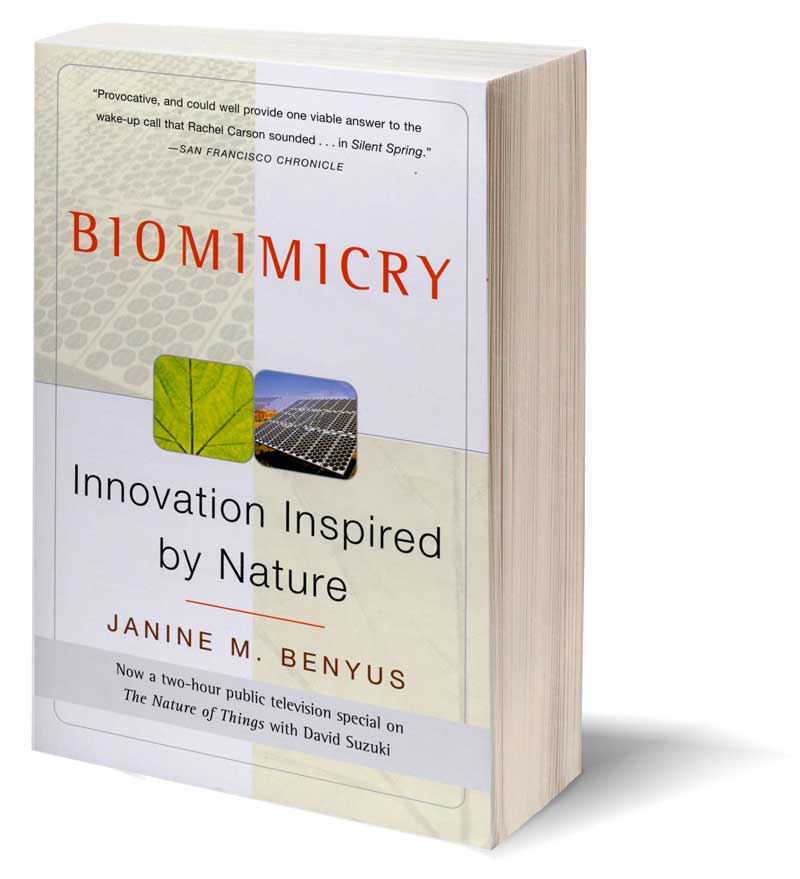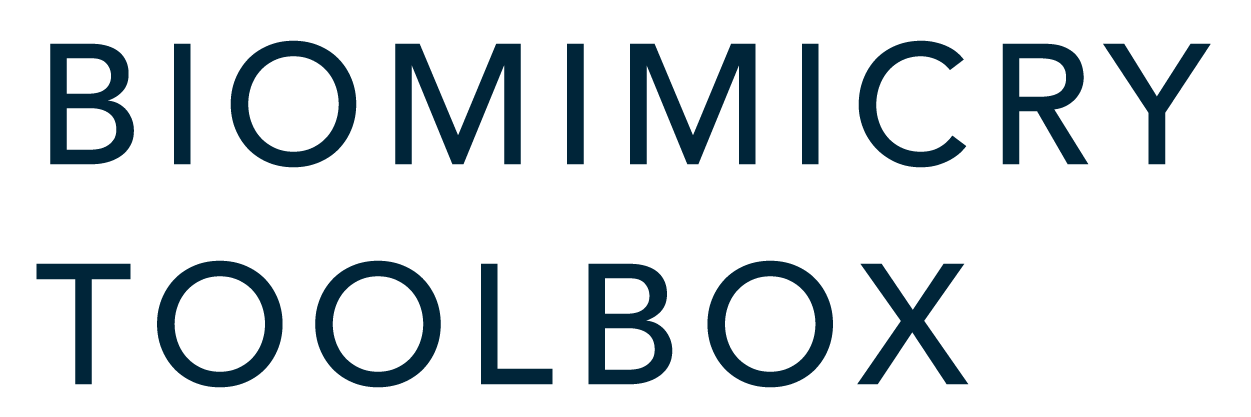Reading List
Our favorite selections and recommended reading for those new to biomimicry.Featured Title

by Janine Benyus, Biomimicry Institute co-founder
First published in 1997, this book brought biomimicry into the public eye, detailing how science is studying nature’s best ideas to solve our toughest 21st-century problems.
Bioinspired Design
Ed. Yoseph Bar-Cohen,2005
Explores biological models useful to engineering and the challenges awaiting future research.
Biomimicry and Architecture
Michael Pawlyn, 2011
Explores the application of biomimicry to architecture; rich with examples and possibilities for a bio-inspired future of architecture.
Bionics in Action: The Design Work of Franco Lodato, Motorola
Jens Bernsen, 2004
Franco Ladato, a designer whose career includes work for DuPont, Gillette, and now Motorola, has studied bionics and natural design and how it has influenced his designs. This book is filled not just with product images, but also photos and sketches of nature.
Bulletproof Feathers: How Science Uses Nature’s Secrets to Design Cutting-Edge Technology
Robert Allen, 2010
Overview of research in biomimetics; includes materials, robotics, and architecture.
Cat’s Paws and Catapults: Mechanical Worlds of Nature and People
Steven Vogel, 1998
Investigates whether nature or human design is superior and why the two technologies have diverged so much.
Green Chemistry: Theory and Practice
Paul T. Anastas and John Charles Warner, 2000
Overview of the design, development, and evaluation process central to green chemistry. Explores alternative solvents and catalysts, benign syntheses and biomimetic principles, among many other topics.
Inspired by Nature: Animals: The Building/ Biology Connection
Alejandro Bahamon, 2009
Focuses on specific analogies, comparing and contrasting techniques and materials used in animal constructions with examples of human architecture.
The Gecko’s Foot: Bio-inspiration, Engineering New Materials and Devices from Nature.
Peter Forbes, 2005
Presents technologists’ pure research into nano-anatomy, followed by their applied and, as many entrepreneurs hope, commercial mimicry of nature’s ingenuity.
Nature Design: From Inspiration to Innovation
Angeli Sachs, 2007
Almost completely filled with photographs, this book explores the discovery of nature in the Art Nouveau period from the 1930s to the 1970s.
Nature Got There First: Inventions Inspired By Nature
Phil Gates, 2010
Nature is full of amazing designs and ‘mechanisms’ that appear to have inspired the engineering and technology we use today.
The Shark’s Paintbrush: Biomimicry and How Nature is Inspiring Innovation
Jay Harman, 2013
In The Shark’s Paintbrush, Harman introduces us to pioneering engineers in a wide array of businesses who are uncovering and copying nature’s hidden marvels.
The Sand Dollar and the Slide Rule: Drawing Blueprints from Nature
Delta Willis. 1995
Exploring the relationship between natural forms and human design, Delta Willis’ book examines topics such as wings and flight, economy of motion and divine math.
Secret Design Rules of Nature (Optimum Shapes Without Computers)
Claus Mattheck, 2007
Looks at the rules implicit in nature’s solutions to design problems. Aimed at the craftsman as much as the builder or engineer, he demonstrates using simple graphical methods how the rules underlying appropriate shape and form in the natural world can be applied to man-made designs.
Natural Inspiration
Animal Architects: Building and the Evolution of Intelligence
James R. Gould & Carol Grant Gould, 2007
Not only delving into how animals such as birds and beavers build, this book also links animal architecture with associated behavioral data.
Exploring the Way Life Works: The Science of Biology
Mahlon B. Hoagland et. al., 2001
Comprehensive illustrated overview of the natural world from patterns in life to energy and evolution.
Life’s Devices: The Physical World of Animals and Plants
Steven Vogel, Rosemary Calvert, 1988
This is an entertaining and informative book that describes how living things bump up against non-biological reality.
The Extended Organism: The Physiology of Animal-Built Structures
J. Scott Turner, 2000
Can structures be called “living”? These structures, after all, do many of the same functions such as capture and channel energy for the creatures. In this book, Turner explores how animal architecture functions as external organs for the inhabitants.
Extreme Nature (Smithsonian Institution)
Mark Carwardine, 2005
Interesting facts and figures about some of the most interesting natural phenomena on earth. From the “most devious plant” to the “strangest nesting material”, this book is packed full of interesting information about both common and uncommon organisms.
The Hidden Powers of Animals
Karl P.N. Shuker, 2001
A fascinating look at the astonishing behavior and super-human abilities of animals, from kings of the jungle to household pets. This book reveals incredible truths about animals and their remarkable sensitivities, skills and strengths.
The Way Nature Works
Ed. Jill Bailey, 1992
Drawing on a series of questions that children might ask, a team of scientists proposes answers in this manual for adult readers. They address large issues such as atmospheric phenomena, ecosystem relationships, and animal communication with brief essays, each well illustrated with charts, diagrams, and photographs.
Weird Nature
John Downer. Firefly Books, 2002
Some of the most fantastic behaviors of real animals are explored in this beautifully illustrated companion volume to a BBC/ Discovery Channel series.
Connecting with Nature
Joseph Cornell, 1987
This gem contains photos of nature, inspirational poetry and exercises for reconnecting with nature.
The Practical Naturalist: Explore the Wonders of the Natural World
Chris Packham, 2010
This beautifully illustrated book gets you outside and gives tips for experiencing the wonders of the natural world.
Reconnecting with Nature: Finding Wellness Through Restoring Your Bond with the Earth
Michael J. Cohen, 2001
Comprehensive overview of the natural world from patterns in life to energy and evolution. Devoted to the wonder and unity of the natural world.
Subjects and keywords for further exploration
- Agriculture: polyculture, permaculture, perennial agriculture, restoration, biodiversity
- Biology & Natural Sciences: adaptation, biosphere, ecosystems, food web, symbiosis
- Chemistry: green chemistry, water-based chemistry, biochemistry, supramolecular chemistry
- Computer Science & Mathematics: patterns, fractal theory, systems theory, emergence, natural algorithms, feedback loops, self organizing systems, golden ratio, Fibonacci, spiral
- Design & Architecture: adaptable, multifunctional, sustainable design, “cradle-to-cradle” design, living buildings, biophilic design, life-cycle design, systems thinking, integrated chain management, modular and nested design, biofacade
- Economics/Business: natural capitalism, systems, industrial symbiosis, industrial ecology, cooperation, ecosystem, resilience, systems thinking, feedback loops
- Engineering & Mechanics: sustainable engineering, biomechanics, fluid mechanics, bioengineering, multi-functional
- Materials Science: biomaterials, biomineralization, nanotechnology, self-assembly, green chemistry, biopolymer, self-healing, self-repairing, recycle, upcycle


